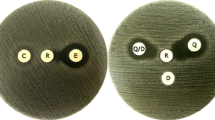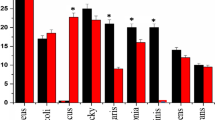Summary
We have studied thein-vitro activity of erythromycin, vancomycin and pristinamycin against 1,006 clinical isolates comprising streptococci, staphylococci,Neisseria gonorrhoeae, Haemophilus influenzae and anaerobes.In-vitro studies show pristinamycin to inhibit staphylococci and streptococci, including erythromycin highly-resistant organisms, at a concentration of ≤ 0.78 mg/l. Although pristinamycin's mean MIC for streptococci is higher than that of erythromycin, pristinamycin is bactericidal, whereas erythromycin is bacteristatic againstStreptococcus agalactiae and oral streptococci. Enterococci were less uniformly susceptible to pristinamycin: 58 of the 94Enterococcus faecalis tested were resistant (MIC ≥ 3.12 mg/l). 14 of the 15 isolates ofEnterococcus faecium were inhibited by ≤ 1.56 mg/l pristinamycin. Pristinamycin showed poor activity againstHaemophilus influenzae (mode MIC 1.56 and MIC90 of 3.12 mg/l) but all except two of the 100Neisseria gonorrhoeae tested were inhibited by ≤ 0.78 mg/l pristinamycin. Pristinamycin inhibited all nineClostridium spp. at ≤ 0.39 mg/l and 38 of 40 strains of anaerobic gram-positive cocci at ≤ 0.78 mg/l. It was less effective against theBacteroides fragilis group: (MIC90 3.12 mg/l). Pristinamycin had poor bactericidal activity against the anaerobes tested.
Zusammenfassung
Wir haben das In vitro-Verhalten von Erythromycin, Vancomycin und Pristinamycin gegenüber 1006 klinischen Isolaten, zusammengesetzt aus Streptokokken, Staphylokokken,Neisseria gonorrhoeae, Haemophilus influenzae und Anaerobiern untersucht. Die In vitro-Untersuchungen zeigen, daß Pristinamycin Staphlokokken und Streptokokken bei einer Konzentration von ≤ 0,78 mg/l hemmt, einschließlich der gegen Erythromycin hoch resistenten Stämme. Obwohl die mittlere MHK von Pristinamycin für Streptokokken höher ist als die des Erythromycin, ist Pristinamycin bakterizid. Dagegen wirkt Erythromycin aufStreptococcus agalactiae und orale Streptokokken bakteriostatisch. Enterokokken reagierten weniger gleichbleibend auf Pristinamycin. 58 der 94 getestetenEnterococcus faecalis-Isolate waren resistent (MHK ≥ 3,12 mg/l). 14 von 15Enterococcus faecium-Isolaten wurden durch ≤ 1,56 mg/l Pristinamycin gehemmt. Pristinamycin zeigte eine geringe Aktivität gegenüberHaemophilus influenzae (Mittlere MHK 1,56 mg/l und MHK90 3,12 mg/l). Alle bis auf zwei der getesteten 100Neisseria gonorrhoeae-Isolate wurden durch ≤ 0,78 mg/l Pristinamycin gehemmt. Pristinamycin hemmte alle neunClostridium spp. bei ≤ 0,39 mg/l und 38 von 40 Stämmen anaerober grampositiver Kokken bei ≤ 0,78 mg/l. Pristinamycin war weniger erfolgreich gegen dieBacteroides fragilis-Gruppe: (MHK90 3,12 mg/l). Pristinamycin zeigte nur wenig Aktivität gegenüber den Anaerobiern.
Similar content being viewed by others
References
Shanson, D. C.;Akash, S., Harris, M., Tadayon, M. Erythromycin stearate 1.5 g for the oral prophylaxis of streptococcal bacteraemia in patients undergoing dental extraction: efficacy and tolerance. J. Antimicrob. Chemother. 15 (1985a) 83–90.
Garelts, J. C., Peterie, J. D. Vancomycin and the red man's syndrome. N. Engl. J. Med. 312 (1981) 245.
Cook, F. U., Farrar, W. E., Jr. Vancomycin revisited. Ann. Intern. Med. 88 (1978) 813–818.
Sorrell, T. C., Collignon, J. C. A prospective study of adverse reactions associated with vancomycin therapy. J. Antimicrob. Chemother. 6 (1985) 235–241.
Prud'homme, J., Torridie, P., Belloc, A. Pristinamycin characterisation and identification of its constitutents. Bull. Soc. Chim. Fr. 2 (1958) 5895–9.
Le Goffic Structure activity in lincosamide and streptogramin antibiotics. J. Antimicrob. Chemother. 16 Suppl. A (1985) 13–21.
Berteaux, S., Bouanchaud, D. H.: Lasting effects of P2 components of pristinamycin onStaphylococcus aureus. Proceedings of the 12th International Congress of Chemotherapy 1981, pp. 90–92.
Maskell, J. P., Williams, J. D. In-vitro susceptibility of oral streptococci to pristinamycin. J. Antimicrob. Chemother. 19 (1987) 585–590.
Lafaix, Ch., Bouvet, E., Dublanchet, A., Dabernat, H., Carrere Cl., Picq, J. J., Etienne, J. Thein vitro activity of pristinamycin againstHaemophilus influenzae undNeisseria meningitidis. J. Antimicrob. Chemother. 16 Supp. A (1985) 221–223.
Thabaut, A., Meyran, M., Huerre, M. In vitro comparison of macrolides, lincosamides and synergistins onNeisseria gonorrhoeae. J. Antimicrob. Chemother. 16 Suppl. A (1985) 213–215.
Miles, A. A., Misra, S. S., Irwin, J. O. The estimation of the bactericidal power of the blood. J. Hyg., Cambridge, 38 (1938) 732–49.
Vazquez, D. The streptogramin family of antibiotics. In:Gottlieb, D., Shaw, P. D. (eds.).: Antibiotics. Springer-Verlag, Berlin 1967, pp. 387–403.
American Heart Association Committee Report: Prevention of bacterial endocarditis. Circulation 56 (1977) 139A-143A.
Duval, J. Evolution and epidemiology of MLS resistance. J. Antimicrob. Chemother. 16 Suppl. A (1985) 137–149.
Weisblum, B., Demohn, V. Erythromycin-inducible resistance inStaphylococcus aureus. Survey of antibiotic classes involved. J. Bacteriol. 98 (1969) 447–452.
Moellering, R. C., Jr., Korzeniowski, O. M., Sande, M. A., Wennersten, C. B. Species specific resistance to antimicrobial synergism inStreptococcus faecium andStreptococcus faecalis. J. Infect. Dis. 140 (1979) 203–208.
Chen, H. Y., Williams, J. D. The killing effects of cefathiamidine or ampicillin alone and in combination with gentamicin against enterococci. J. Antimicrob. Chemother. 12 (1983) 19–26.
Krogstad, D. J., Parquette, A. R. Defective killing of enterococci: a common property of antimicrobial agents acting on the cell wall. Antimicrob. Agents Chemother. 17 (1980) 965–968.
Watanakunakorn, C., Bakie, C. Synergism of vancomycin-gentamicin and vancomycin-streptomycin against enterococci. Antimicrob. Agents Chemother. 4 (1973) 120–124.
Chen, H. Y., Williams, J. D. The activity of vancomycin and teicoplanin alone and in combination with gentamicin or ampicillin againstStreptococcus faecalis. Eur. J. Clin. Microbiol. 3 (1984) 436–438.
McDonald, M. I., Hurse, A., Sim, K. W. Methicillin-resistantStaphylococcus aureus bacteraemia. Med. J. Aust. 2 (1981) 191–195.
Boyce, J. M., Causey, W. A. Increasing occurrence of methicillin-resistantStaphylococcus aureus in the United States. Infect. Control 3 (1982) 377–383.
Shanson, D. C., Johnstone, D., Midgley, J. Control of a hospital outbreak of methicillin-resistantStaphylococcus aureus infections: value of an isolation unit. J. Hosp. Infect. 6 (1985b) 285–292.
Kucers, A. Vancomycin. J. Antimicrob. Chemother. 14 (1984) 564–567.
Thabaut, A., Meyran, M., Huerre, M. Evolution and present situation ofStaphylococcus aureus sensitivity to MLS in hospital (1975–83). J. Antimicrob. Chemother. 16 Suppl. A (1985) 205–207.
Beauvais, P., Filipe, G., Berniere, J., Carlioz, H. Oral pristinamycin for bone and joint infections in children. A report of 50 cases. Arch. Fr. Pediatr. 38 (1981) 489–493.
Bastin, R., Rapin, M., Kernbaum, S. Controlled study of pristinamycin versus oxacillin in staphylococcal infections. Pathol. Biol. (Paris), 30, 6 Part 2 (1982) 473–475.
Author information
Authors and Affiliations
Rights and permissions
About this article
Cite this article
Maskell, J.P., Sefton, A.M., Williams, J.D. et al. Comparative in-vitro activity of erythromycin, vancomycin and pristinamycin. Infection 16, 365–370 (1988). https://doi.org/10.1007/BF01644551
Received:
Accepted:
Issue Date:
DOI: https://doi.org/10.1007/BF01644551




